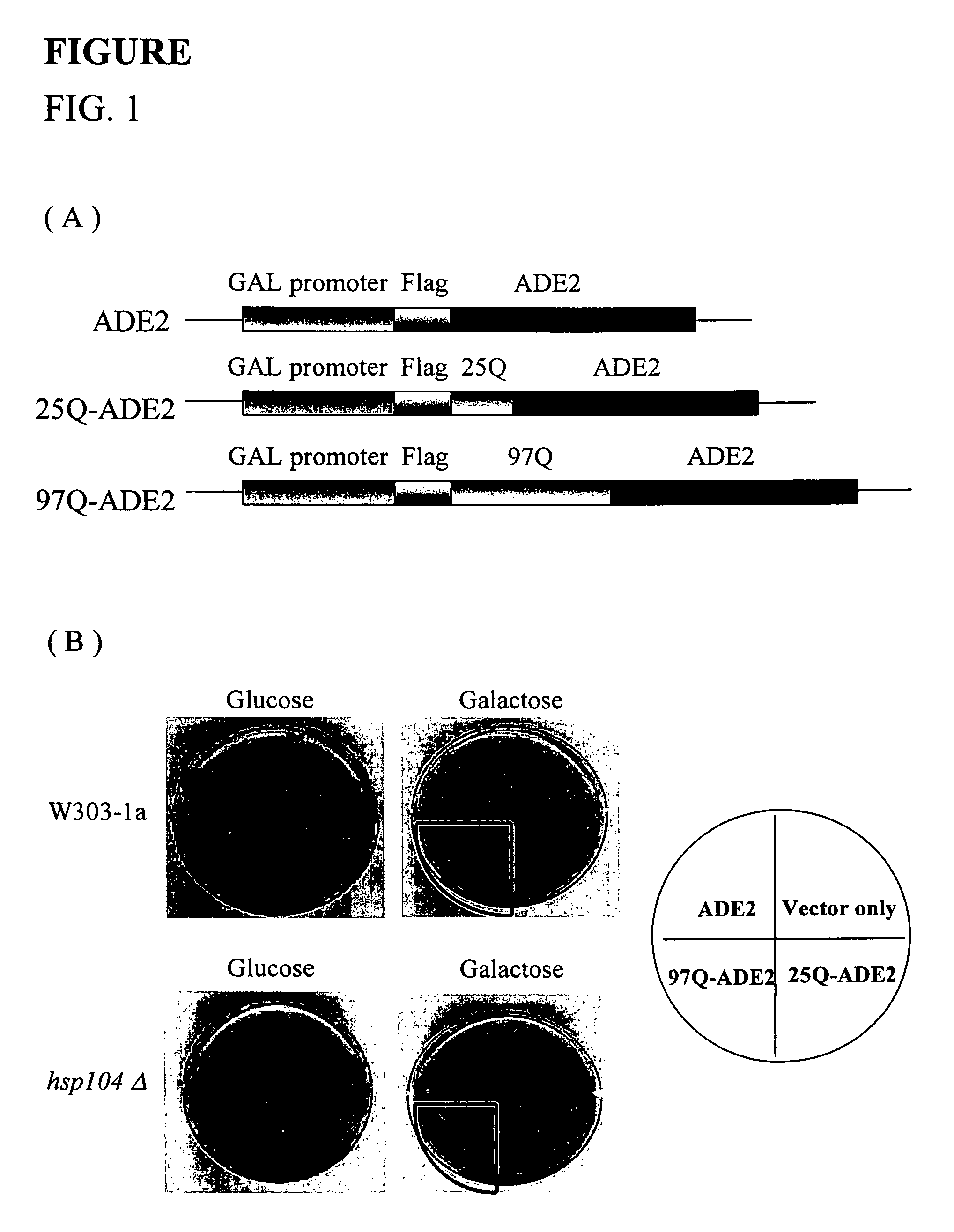Recombinant protein and method of screening for agents that modulate polypeptide aggregation
a polypeptide and aggregation technology, applied in the field of recombinant protein and a screening method for neurodegenerative diseases, can solve the problems of limited methods, inability to uncover other potential targets, and impaired protein aggregation resulting from extended polyglutamine repeats
- Summary
- Abstract
- Description
- Claims
- Application Information
AI Technical Summary
Problems solved by technology
Method used
Image
Examples
example 1
Color-Based Reporter System Construction
[0040]In order to establish a color-based reporter system in which the activity of gene products was dependent on the solubility of the proteins to study the processes of polyglutamine-mediated protein aggregation. Huntingtin's exon1 sequences containing the first 17 amino acids followed by 25 or 97 glutamine residues were fused in frame with ADE2, and a FLAG tag was attached to their amino termini (designated as 25Q-ADE2 and 97Q-ADE2, FIG. 1(A)). The expression of 25Q-ADE2 or 97Q-ADE2 was under the control of Gall promoter; thus, the reporter proteins did not express when the cells were cultured in the medium containing glucose until the change of carbon source to galactose. To test whether the constructs created here were able to show a correlation between the length of polyglutamine and colony-color phenotypes, plasmids 25Q-ADE2 or 97Q-ADE2 were transformed into W303-1a yeast strain. As controls, vectors without any inserted DNA or with ADE...
example 2
Filter Trap and Slot-Blot Assay
[0044]Electron micrographs of insoluble protein aggregates of mutant huntingtin fragments revealed a fibril or ribbon-like morphology, reminiscent of beta-amyloid fibrils in Alzheimer's disease. The fibrils showed a length varied from 100 nm up to several micrometers. Therefore, this unique physical characteristic of the aggregates could be detected biochemically using a filter trap assay in which only proteins with size more than 0.2 micrometers retain on a cellulose acetate membrane (Scherzinger et al., 1997, Cell 90, 549-558). In order to validate the colony-color phenotypes observed in the genetic experiments were caused by the formation of ADE2 protein aggregates, cell lysates were prepared and subjected to filter trap assays.
[0045]While equal amounts of total proteins were loaded from different ADE2 constructs and strain backgrounds, only 97Q-ADE2 fusion proteins from W303-1a cells were trapped on the cellulose acetate (CA) membrane (FIG. 2(A), b...
example 3
Validation For Color-Based System in Drug Screening
[0048]Hsp104p was a member of the Hsp100p families and it could facilitate the solubilization of aggregated proteins caused by heat or stress. It has been known that Hsp104p was also involved in the formation of protein aggregates with expanded polyglutamine stretch in yeast cells. In the absence of Hsp104p function, yeast cells did not show the appearance of polyglutamine protein aggregation, indicating Hsp104p was a necessary component for the genesis of the protein aggregates. The activity of Hsp104p could be modulated by a well-studied chemical inhibitor, guanidine hydrochloride. This chemical reagent, at a concentration of mM, could penetrate into yeast cells and block the ATPase activity of Hsp104p, which was essential for the enzymatic activity of the protein. It was known that yeast cells subjected to guanidine hydrochloride treatment dramatically lost their ability to form polyglutamine protein aggregates through the inhibi...
PUM
| Property | Measurement | Unit |
|---|---|---|
| concentrations | aaaaa | aaaaa |
| length | aaaaa | aaaaa |
| size | aaaaa | aaaaa |
Abstract
Description
Claims
Application Information
 Login to View More
Login to View More - R&D
- Intellectual Property
- Life Sciences
- Materials
- Tech Scout
- Unparalleled Data Quality
- Higher Quality Content
- 60% Fewer Hallucinations
Browse by: Latest US Patents, China's latest patents, Technical Efficacy Thesaurus, Application Domain, Technology Topic, Popular Technical Reports.
© 2025 PatSnap. All rights reserved.Legal|Privacy policy|Modern Slavery Act Transparency Statement|Sitemap|About US| Contact US: help@patsnap.com



